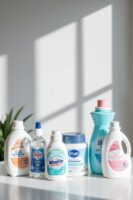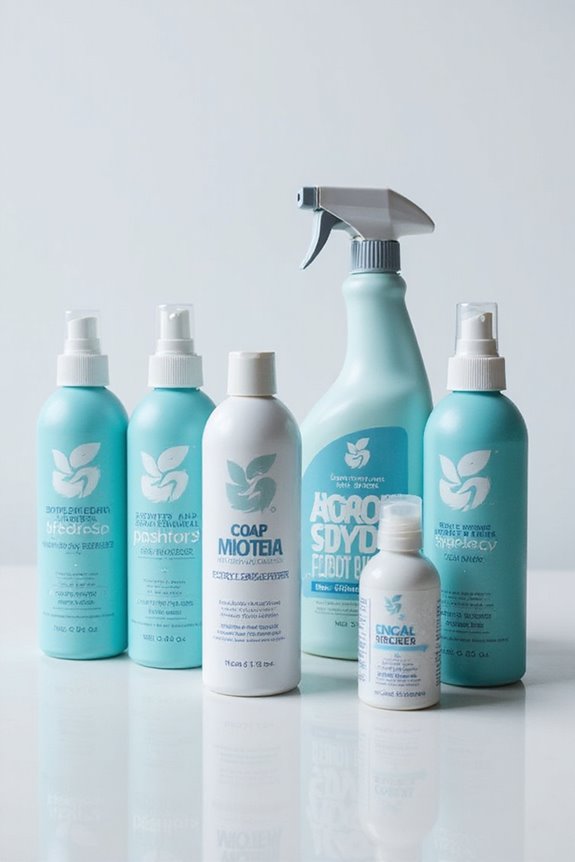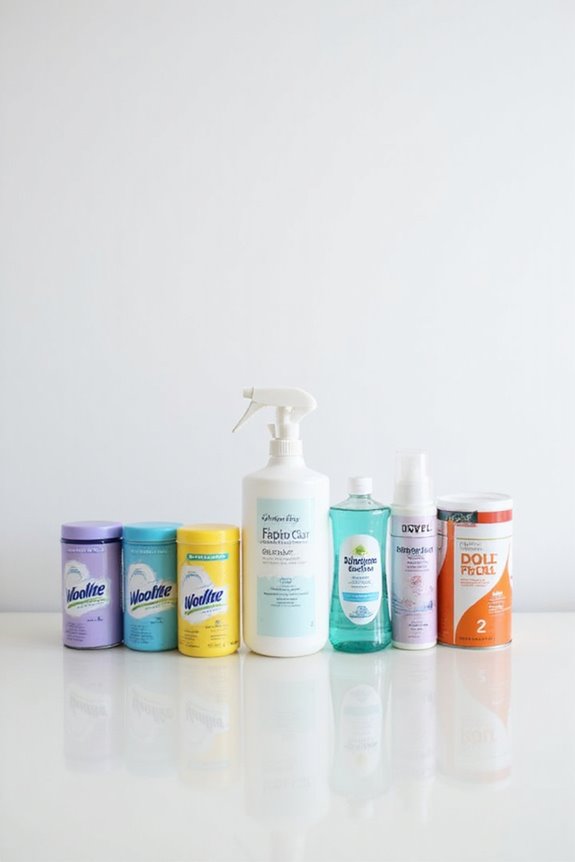Fabric refreshers typically contain water, which acts as the main ingredient and helps spread everything evenly. Alcohol joins the mix to dissolve fragrances and aid drying. We often see odor neutralizers like hydroxypropyl cyclodextrin capturing unpleasant smells, along with essential oils that leave our fabrics smelling great. Some products even mix in baking soda for that extra freshness boost! If you’re curious about what makes different brands stand out, there’s more to explore ahead!
Key Takeaways
- Fabric refreshers commonly use water as a base ingredient for even dispersion and quick drying without mineral deposits.
- Alcohol serves as a solvent for essential oils and fragrances, promoting even distribution and quick drying.
- Odor neutralizers like hydroxypropyl cyclodextrin and diethylene glycol capture and lock away unpleasant smells effectively.
- Fragrances and essential oils provide pleasant scents, with some products opting for synthetic fragrances or offering fragrance-free options.
- Eco-friendly options are available, featuring sustainable ingredients that appeal to environmentally conscious consumers.
Water as a Base Ingredient
When we think about fabric refreshers, it’s easy to overlook one essential ingredient: water. This simple liquid is packed with water benefits. It acts as the primary solvent, helping disperse ingredients like essential oils and odor neutralizers evenly across fabrics. We love using distilled water, since it avoids mineral deposits that could stain our favorite cushions.
When applied, water helps break down odor-causing molecules and guarantees quick drying, which prevents mildew. If you’ve ever made a homemade refresher, you know it’s often just distilled water mixed with essential oils. While tap water can work, it might introduce unwanted residues. So, whether it’s for a DIY project or a store-bought spray, water truly deserves to be celebrated in our fabric refreshers!
The Role of Alcohol in Fabric Refreshers
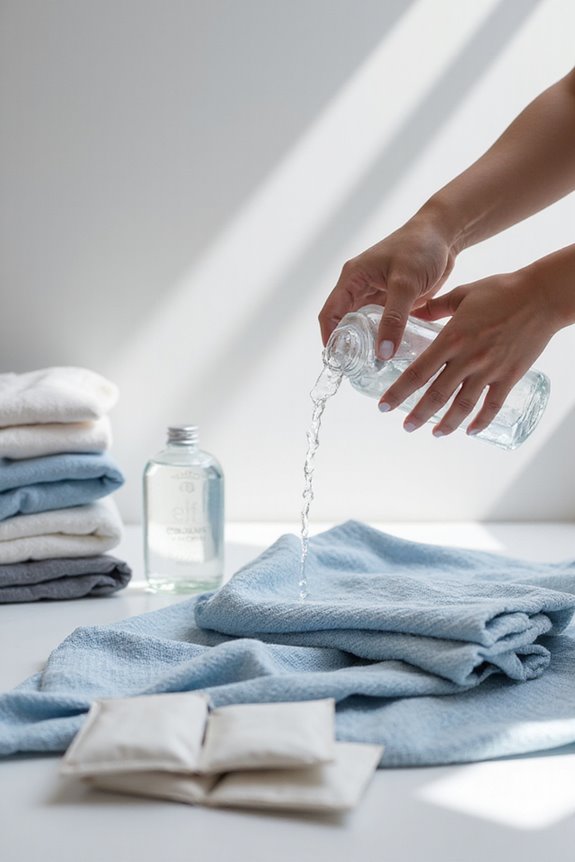
Alcohol plays an essential role in fabric refreshers, enhancing both their effectiveness and user experience. It acts as a solvent, dissolving essential oils and fragrances for even distribution. This means we get a nice, balanced spray mist without heavy liquid drips. Plus, alcohol helps our fabric refreshers dry quickly, preventing those annoying wet spots.
One of the coolest alcohol benefits is its ability to fight odor-causing bacteria, keeping our fabrics fresher longer. But, we should keep alcohol safety in mind; using it in proper concentrations protects our fabrics and guarantees we don’t inhale too much of those concentrated vapors. So, let’s appreciate alcohol in our fabric refreshers—it’s a multitasker that really knows how to work!
Understanding Odor Neutralizers
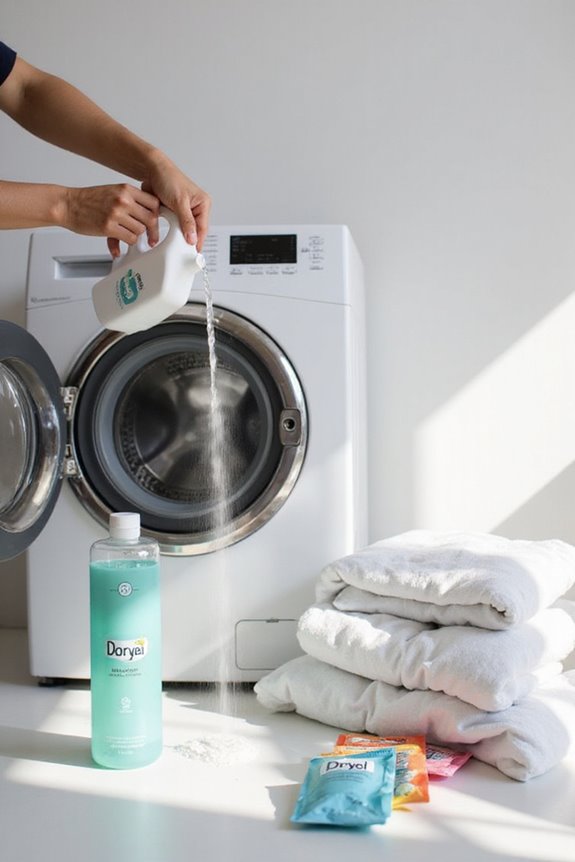
Odor neutralizers are fascinating little heroes in the world of fabric refreshers. They work behind the scenes to tackle stubborn smells. First up, we’ve got hydroxypropyl cyclodextrin, which traps odor molecules in a molecular cage, effectively keeping them from escaping. It teams up with diethylene glycol to capture a broad range of odors.
Then, there’s sodium citrate and sodium maleate, both of which help with pH balancing. By neutralizing the acidity or basicity of odors, they make those offensive smells much less noticeable. We’ve even tested these ingredients ourselves, and the difference is real! Together, these odor-trapping and pH-balancing agents help keep our fabrics smelling fresh. Who knew chemistry could smell so good? This technology mirrors the effectiveness of hypoallergenic detergents, which also aim to provide a gentle yet effective clean without harsh chemicals.
Fragrances and Essential Oils
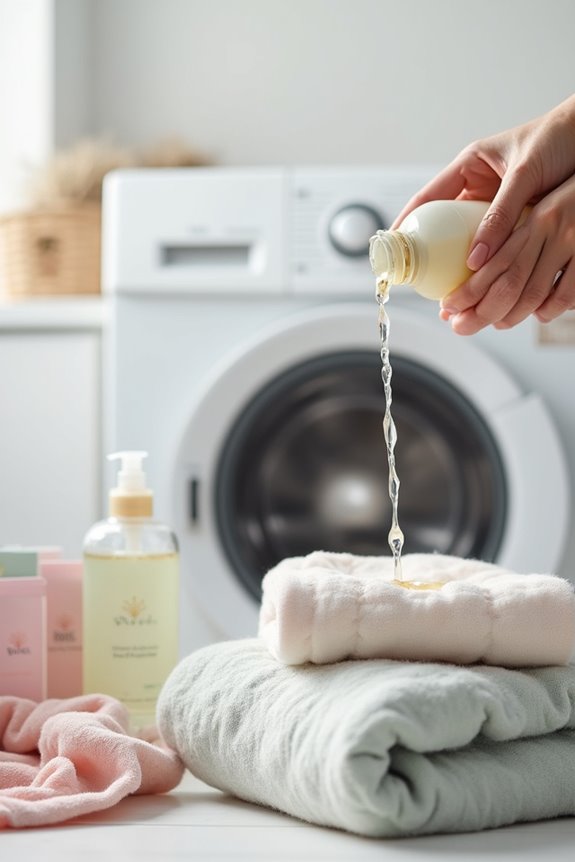
Fragrances and essential oils play a crucial role in making fabric refreshers not only effective but also enjoyable to use. We often pick products that offer a pleasant natural scent, and that’s where fragrance blending comes into play. Some fabric refreshers use synthetic fragrances that quickly mask odors, while others rely on essential oils like lavender or lemon for a fresh aroma.
Essential oils are great for DIY enthusiasts, too. Just 10-15 drops per spray bottle can deliver a lasting scent without overpowering our senses. Plus, they often come with added benefits, like deodorizing properties. However, we should always be cautious of sensitivities, especially around pets. After all, we want our refreshers to smell great without causing any sneezes! Additionally, many fragrance-free options, such as Zero Odor Multi-Purpose Strong Odor Eliminator, effectively neutralize odors without relying on any scents.
Baking Soda: An Optional Ingredient
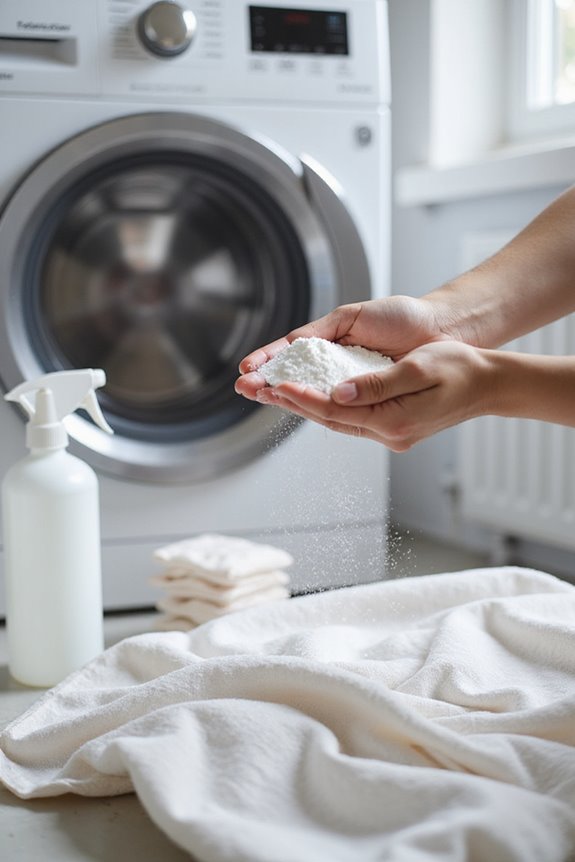
When it comes to fabric refreshers, baking soda is like that reliable friend who’s always got your back. It neutralizes odors instead of just covering them up, making it a fantastic addition to our homemade sprays. We’ve found that adding 1 to 2 tablespoons of baking soda to a spray bottle enhances its deodorizing power. Plus, it’s non-toxic and eco-friendly—no industrial chemicals here!
Now, if you’re looking for baking soda alternatives, there are options like essential oils or vinegar, but they might not pack the same punch. In fact, many commercial fabric refreshers, like Febreze Odor-Fighting Fabric Refresher, effectively neutralize tough odors with safe ingredients. Whether we’re tackling tough smells or just revitalizing our fabrics, baking soda brings some serious benefits. So, let’s consider it an optional but mighty ingredient in our fabric refresher arsenal!
Specific Odor-Trapping Ingredients
We all know that baking soda does a fine job at neutralizing odors, but there’s a whole world of specialized ingredients out there that really take fabric refreshers to the next level. One standout is (hydroxypropyl) cyclodextrin. This ingredient captures and locks away odors in molecular cages, offering impressive cyclodextrin benefits for effective odor trapping.
Another key player is diethylene glycol, which works with cyclodextrin to capture various odor molecules, enhancing the overall effectiveness. Then we have polyamine polymers, which act like odor magnets, locking in tough smells. Didecyldimonium chloride tackles odor at its source by preventing microbial growth. Together, these ingredients make fabric refreshers powerful allies against unwanted smells, leaving our fabrics fresh and inviting.
Odor-Neutralizing Compounds
Odor-neutralizing compounds play an essential role in making our fabric refreshers effective. For instance, sodium citrate and sodium maleate are pH balancing agents derived from citrus and tart fruits. They help to neutralize unpleasant odors, making them less noticeable. Adjusting the pH can actually change the chemical state of odor molecules, reducing their volatility.
Then there’s beta-cyclodextrin, a carbohydrate that works like a little doughnut, trapping those pesky odor molecules inside its structure. This cyclodextrin effectiveness means that as our fabric refresher dries, it captures more odors, lowering their concentration in the air. Together, these ingredients guarantee that our fabrics smell fresh, not funky!
Stabilizers and Preservatives
After tackling those pesky odors, we need to think about how to keep our fabric refreshers fresh and effective over time. This is where stabilizers and preservatives come into play! They help maintain product quality and safety. For instance, sodium benzoate is a popular choice. It’s non-toxic and safe, found naturally in fruits—talk about preservative safety!
We also have plant-derived systems like benzyl alcohol, which not only preserve but help dissolve other ingredients for better performance. Stabilizers, such as phosphoric acid, guarantee our formulas stay stable, preventing ingredient separation. They’re like the unsung heroes in our fabric refreshers, guaranteeing everything works together smoothly. So, next time we spritz our fabrics, we can appreciate these hard-working ingredients!
Additional Functional Ingredients
When you think about fabric refreshers, it’s easy to focus on just the pleasant scents, but there’s a whole world of functional ingredients that make them effective. For instance, magnesium compounds like magnesium nitrate and magnesium chloride help stabilize the formula, keeping everything consistent. Then there’s denatonium benzoate, which sounds fancy but serves a simple purpose: it discourages anyone from drinking the spray—definitely a good thing! We often forget that essential oils do more than smell great; they also fight off odor-causing bacteria. Plus, baking soda enhances odor absorption, making it a popular choice in DIY recipes. So, next time you spritz your fabrics, remember there’s more behind that fresh scent than meets the eye!
Variations in Commercial Product Ingredients
Variations in commercial fabric refreshers can really make a difference in how well they work for us. When we look at formulation variations, it’s clear that different brands use unique ingredient sourcing methods. For instance, some might rely on natural essential oils, while others opt for synthetic aroma chemicals to create distinctive scents. Alcohol content is often higher in professional products, giving them a stronger punch. Meanwhile, consumer versions balance mildness with effectiveness. We’ve noticed that surfactants and emulsifiers play key roles too, helping to evenly disperse fragrances and improve fabric feel. Additionally, many commercial sprays incorporate eco-friendly options that cater to environmentally conscious consumers. So, whether we’re sprucing up a living room or tackling stubborn odors, understanding these variations can help us choose the right refresher for our needs.
Frequently Asked Questions
Are Fabric Refreshers Safe for All Types of Fabrics?
When considering fabric refreshers, we should be aware that not all fabric types are equally safe. Our safety concerns should focus on delicate materials, as they might be damaged by certain ingredients. Always test beforehand!
How Often Should I Use Fabric Refresher Sprays?
When it comes to fabric refresher sprays, we recommend using them based on frequency recommendations. For best results, consider usage tips like fabric type and odor intensity, ensuring we maintain a fresh environment without overdoing it.
Can I Make My Own Fabric Refresher at Home?
Sure, we could splurge on pricey store-bought fabric refreshers, but why not embrace DIY alternatives? With simple homemade recipes, we can create effective solutions that smell delightful and save us money—plus, it’s fun!
Are There Any Allergens in Fabric Refresher Ingredients?
When we consider allergen sensitivity in fabric refreshers, ingredient transparency is essential. Many common ingredients can provoke reactions, so it’s wise for us to choose products carefully or consider making our own for safety.
How Should I Store Fabric Refresher Products?
When we think about fabric refreshers, proper storage is like a protective embrace, ensuring our products’ shelf life flourishes. Let’s keep them cool, dry, and away from sunlight to maintain their revitalizing magic!



